A Guide to The Best Knife Sharpeners
Published On: 5/23/2019 Last Modified: 6/16/2025
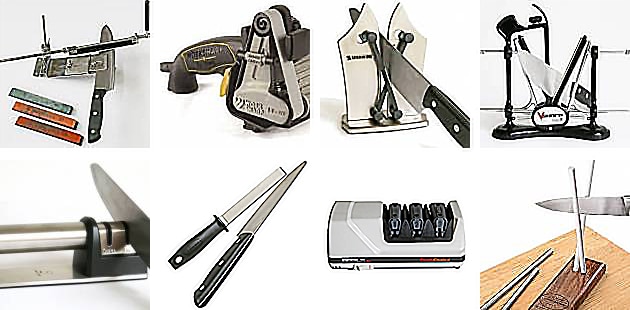
A dull knife makes kitchen work harder, and it is downright dangerous. When a dull knife is placed against something like the skin of an apple or onion it can skid along the surface and fly toward your fingers. A sharp knife easily sinks into the food, needs less pressure, and gives you more control.
Click Here To Search Our Reviews And Ratings Of Tools, Toys, And Accessories
If you have Tony the Knife Sharpener, an Italian immigrant who calls comes through Meathead’s neighborhood, you don’t need a knife sharpening device. Otherwise, read on.

Before you buy a knife sharpener, consider your needs, how often you use your knives, and whether you want the sharpening process to be relatively quick and automatic (with, say, an electric sharpener) or more gradual and manual with a set of sharpening stones.
There are three major types of sharpening materials: Carbide, ceramic, and diamond. All actually remove a miniscule bit of metal to produce a new, evenly sharp edge. All of the materials have their uses and price points, and diamond has the longest life by far. These sharpening materials all come in various “grits” of coarseness or fineness.
Generally, you first sharpen with a coarse grit first, then move to a fine grit to finish off your blade with a razor sharp edge. The smaller the grit number, the coarser the material. So 350 grit is more coarse, and 600 is more fine. Across all three materials, there are literally hundreds of knife sharpening devices out there. For these reviews, I selected a representative cross-section of the most common ones.
Sharpener designs

1) Sharpening rods. Two rods, either ceramic or coated with diamond dust, are set in a holder usually at 20˚, 25˚, or 30˚. The rods are used by sliding your knife from top to bottom while pulling or pushing along the entire length of the blade and keeping the blade against the rods. This method is easy to learn and a good way to keep relatively sharp knives sharp. Sharpening rods are fairly inexpensive and can often sharpen serrated knives. They are not useful for sharpening a dull knife.
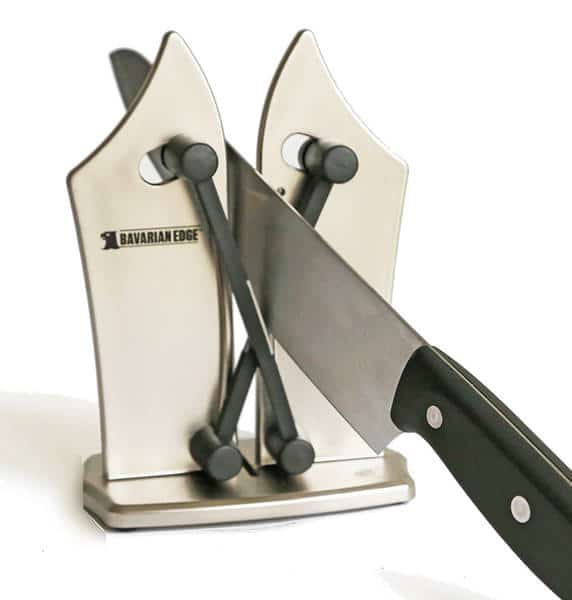
2) V-sharpeners a.k.a. Pull through sharpeners. These are two hardened pieces of tungsten carbide in a hand-held or table-top device in a V-shape. The knife blade is pulled through the V’s several times to sharpen. They are small and easy to keep in a kitchen drawer, can be used to very quickly sharpen blades, can remove small nicks, and are inexpensive. They are, however, inconsistent, as one pull can be too strong and remove too much metal, while a weaker pull does nothing for the other side of the blade. Sometimes the carbide can catch on nicks on the blade, making them worse.
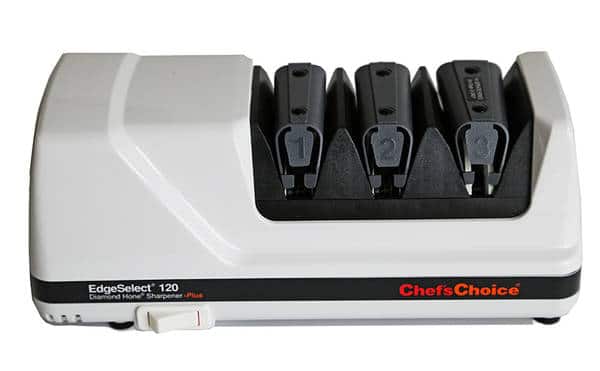
3) Electric sharpeners. Countertop electric sharpeners get the job done quite nicely and much faster than any hand operated sharpening device. They can be moderately to very expensive but do the trick efficiently. Once your blades have been sharpened, you need to use an electric sharpener only once or twice a month to maintain a fine and sharp edge. Most models have either two or three slots, similar to the V-sharpeners, with discs designed for a range of sharpening from rough to very fine. If improperly used, electric sharpeners can wear down a blade rather quickly though, so use caution and moderation with them.
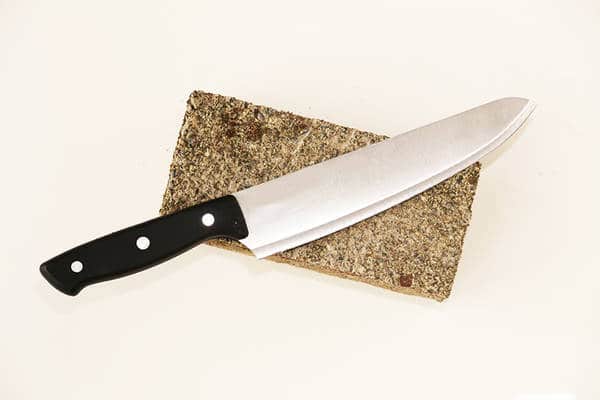
4) Sharpening stone kits. Many experts consider stones to be the best material for sharpening knives. They are also, by far, the most time-consuming to use. A sharpening stone kit typically comes with several flat stones of different coarseness. You start with the roughest and progress to the smoothest. Each stone is lubricated with water or mineral oil. Pick one, you can’t use both.
Water stones need to be soaked in water for at least an hour. With oil stones, you can drizzle oil on the stone just before you begin the sharpening process. Use only mineral oils. Vegetable oils can harden, clog, and ruin a sharpening stone. If you’ve got free time, and don’t mind a repetitive, and somewhat tedious process, have at it.
We are not reviewing sharpening stones at this time. Instead, we will conduct a much more detailed review and test of the best among the huge variety of stones available. We’ll also review the best and worst methods of using sharpening stones.
5) Sharpening steels. These are not sharpeners. Steels cannot remove nicks or sharpen dull blades, and they don’t remove any steel. Instead, they realign the rolled metal edges of knife blade into a straight line, which makes the blade cut better. They are very common and can be used daily to slightly improve a blade’s performance. Steels are easier to use than real knife sharpeners and they are inexpensive. There are three kinds: smooth, ridged, and diamond coated. Because they do not actually sharpen, we did not test any steels at this time. But we do recommend keeping a steel on hand to keep your knife cutting at its best. Here is a link to one we recommend.
6) Strops. A strop is a flat piece of leather, often attached to a thin strip of wood. They have a little flexibility or bend and are used in a similar fashion to steels. However, they are even less effective at sharpening, merely realigning the edges of knives. We did not test any strops, but they are another decent option for honing a knife between uses. We prefer steels.
How I tested
I bought middle of the road chef’s knives at a big box store and all of the tests described below were conducted on these knives. I also tested the sharpeners using some of my own knives, including Henckels, Gerber, Wusthof, and Victorinox chef’s knives.

First, I dulled each knife by running it across a very rough brick a dozen times. I even tapped the blade on a corner of the brick to get some nicks. Then I tested a couple of the dulled knives to see if they were sharp enough to cut a tomato. I guess I did a good job, none of the knives could do more than gouge and mangle the tomatoes. I then followed the instructions for each sharpening device to sharpen the blades as well as I could. After sharpening, I tested each knife by slicing a tomato that sat alone on a cutting board without being held in place.
Then, if necessary, I held and steadied the tomato on the board while trying to slice it. Next, I held and sliced a yellow onion that still had brown skin on it. I also tried to slice off the green tops from carrots in a single stroke. And I cut a thin slice from a styrofoam peanut (this method was suggested by knife master A.G. Russell). Finally, I held an 8 1/2 x 11” piece of ordinary printer paper in my hand and tried to slice it into several pieces. Check out the results below.
Professional Kitchen Sharpening System. It Isn’t Worth The Trouble
This was our least favorite sharpening system of the lot. It works but isn't really worth the effort. Find out why in our review.Chef’s Choice 120 Diamond Hone Pro EdgeSelect Electric Knife Sharpener Review
Chef's Choice 120 Diamond Hone Pro has solid construction, making it a durable sharpener that can even handle commercial use.V-Sharp Classic II (a.k.a. Warthog Sharpener) Looks Complicated But Isn’t
With several moving parts, this knife sharpener looks a bit like Rube Goldberg device and functions well. Check out our review for details.AG Russell Ceramic Knife Sharpening Rods Can Be Used Frequently
This V-sharpener uses ceramic rods set at 15° per side, creating a combined 30° angle on the blade edge. It's a sharpener for frequent use.Bavarian Edge Kitchen Knife Sharpener Isn’t As Great As The TV Ads Claim
This device has two independent spring-action arms made of tungsten carbide, which adjust as you move your knife through the sharpener.PriorityChef Knife Sharpener Is No Frills And Functional
With only two slots, this sharpener is compact, which makes it easy to handle and use, regardless of whether you have large or small hands.Dianova Cook Double Sided Diamond Sharpener, A Handheld Model That Does The Job
The hand-held Dianova Cook Double Sided Diamond Sharpener and its diamond grit surfaces did a good job sharpening straight edge steel knives.Related articles
- Everything You Need to Know About Knives (3 Pages, 2 Articles)
- How to Buy the Best Kitchen Knives
- Electric Knives That Make The Cut
- BBQ And Kitchen Tools, Toys, And Accessories Rated And Reviewed (23 Pages)






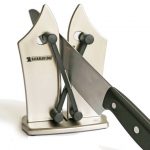



High quality websites are expensive to run. If you help us, we’ll pay you back bigtime with an ad-free experience and a lot of freebies!
Millions come to AmazingRibs.com every month for high quality tested recipes, tips on technique, science, mythbusting, product reviews, and inspiration. But it is expensive to run a website with more than 2,000 pages and we don’t have a big corporate partner to subsidize us.
Our most important source of sustenance is people who join our Pitmaster Club. But please don’t think of it as a donation. Members get MANY great benefits. We block all third-party ads, we give members free ebooks, magazines, interviews, webinars, more recipes, a monthly sweepstakes with prizes worth up to $2,000, discounts on products, and best of all a community of like-minded cooks free of flame wars. Click below to see all the benefits, take a free 30 day trial, and help keep this site alive.
Post comments and questions below
1) Please try the search box at the top of every page before you ask for help.
2) Try to post your question to the appropriate page.
3) Tell us everything we need to know to help such as the type of cooker and thermometer. Dial thermometers are often off by as much as 50°F so if you are not using a good digital thermometer we probably can’t help you with time and temp questions. Please read this article about thermometers.
4) If you are a member of the Pitmaster Club, your comments login is probably different.
5) Posts with links in them may not appear immediately.
Moderators